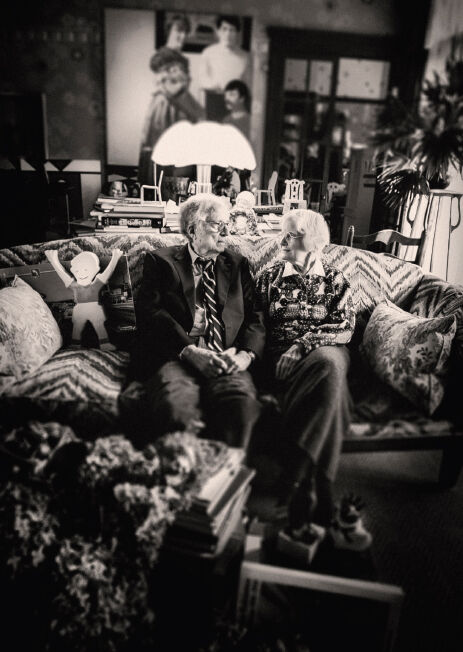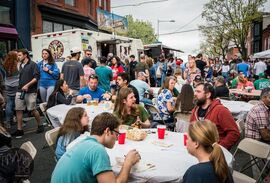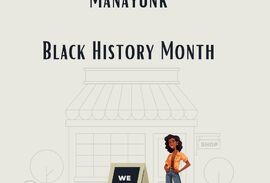COVER PROFILE: Rewriting History - Robert Venturi and Denise Scott Brown Ushered in a New Era of Design

Originally Published In Manayunk.com Magazine
Interview By: Jane Lipton
Robert Venturi and Denise Scott Brown.
Founding Principals, Venturi, Scott Brown and Associates
Update: June 14th 2013 The New York Times
"No Pritzker Prize for Denise Scott Brown”
The Pritzker Prize jury will not revisit its decision to exclude the architect Denise Scott Brown from the 1991 prize given to her design partner and husband, Robert Venturi, with whom she worked side by side.
Let Pritzker know what you think about this: MarthaThorne@PritzkerPrize.com
Writer’s Note: About the Pritzker Architecture Prize from www.Pritzkerprize.com:
Purpose: To honor a living architect whose built work demonstrates a combination of those qualities of talent, vision, and commitment, which has produced consistent and significant contributions to humanity and the built environment through the art of architecture.
The international prize, which is awarded each year to a living architect for significant achievement, was established by the Pritzker family of Chicago through their Hyatt Foundation in 1979. Often referred to as “Architecture’s Nobel” and “the profession’s highest honor,” it is granted annually. (from www.Pritzkerprize.com)
The interview:
Denise, to start, tell me a little bit about this Pritzker prize petition that’s going around…
D –The petition is trying to change the outlook of the givers of the Prize. It was awarded to Bob -- not to both of us -- in 1991, and when Bob heard this he asked that it be made jointly. But he was turned down. Things then simmered for 22 years, but over this period, awareness increased as women entered the profession in large numbers and the Pritzker name and mine were often linked by the word “unfair.”
Feminism was reborn in the US on the heels of the Civil Rights Movement but I was a feminist before that. As a student, I’d sign my full name on my drawings to show they were by a woman. Males predominated in architecture in the 1960s and women received lower pay, a lower status, and fewer jobs than men. The star system conditioned architectural practice, all stars were male, and sexism was the norm. On occasion it would get back to me that I had been referred to in meetings as the “red headed shrew”. In my second teaching position I had to struggle for tenure while a younger and less experienced male architect was offered a full professorship. But my standing was to decline yet further. When Bob and I married, people on meeting me would exclaim “so you’re an architect too!” I learned to reply “no he’s the ‘architect too’” but it wasn’t funny. For some reason, critics and colleagues needed to show that I was just a helper to Bob; they could not conceive of a partnership between us in design. Yet at VSBA we were both leaders and our firm was a joint endeavor of many creative people. The ping pong of ideas amongst us made us what we were.
Now the petition has more than 12,000 signatures and is still growing, and it’s worldwide – “that’s viral in architecture” (she giggles). Although I had nothing to do with forming it, I’m very moved by it, and I’m so proud of its passionate organizers and supporters.
I was born in …
D - Zambia, in Southern Africa. It was called Northern Rhodesia then. People don’t know where it is -- they can’t place me.
B - I’m a lifelong Philadelphian. I was born in Upper Darby, but we moved to the Main Line, then to an apartment building in Germantown, and eventually to a house I designed for my mother in Chestnut Hill. In 1972 Denise and I bought the house in West Mt. Airy that we now live in.
My mother taught me …
D - to love architecture, art , writing, and intellectual challenge. I inherited from her my interest in languages and my enjoyment of “looking around.”
B - to love architecture especially Italian architecture. Even before I was born she wanted me to be an architect, and as a child I would pore over my parents’ picture books of Italian architecture. They made me fall in love with Italy.
My father taught me …
D - to love cities and learn from them. Before work every morning, he would walk the streets of Johannesburg. This was his research as a developer. Later he tried it on other cities, including New York. He had a green thumb for cities.
B – to be concerned with family. The well-being of all our relatives was important to him, and it is to me, and to our son. He too fanned the fires of my love of architecture: once as a small boy, I was driving with him in Manhattan when he stopped the cab at the old Penn Station and took me to see its great Roman interior. I was totally awe struck. It’s one of my most vivid early memories.
Architecture piqued my interest because …
D - as an architect, you look out on the world and “make things” from what you see, from what you learn. Architects aim to design things that are sturdy and functional, culturally and socially useful, adaptable, and beautiful – all at once. Architecture is an adventure, and clients, good clients, will want to explore with you.
B – My whole family, including me, took it for granted that I would be an architect. It was all I ever wanted. Had this failed, I would probably have been an architectural historian.
We met each other at …
B - a faculty meeting at the University of Pennsylvania
D - it was my first faculty meeting and there was a debate on whether a certain building on campus should be demolished. I made a passionate plea, “ tearing it down would be a huge mistake.”
B - After the meeting I walked up to her and said “I agree very much, with what you just said, and my name is Robert Venturi.”
D – So the first thing I said to Robert Venturi was, “if you agreed, why didn’t you say so?” The building, by the way, was designed by Frank Furness and is now Penn’s Fine Arts Library (she says triumphantly).
My greatest hero or inspiration is …
D – I’m not sure about heroes or heroines but I’ve had mentors -- inspiring and nurturing women and men whose memory I love to honor. In my introduction to a book on Josef Frank, a 20th century Austrian architect, I say why his buildings and thought inspire me, and discuss his place in the history of architecture. Then I remember some other refugees, like him, from Hitler, those who helped to educate me on three continents.
B – A few years ago I wrote a list on the dining room wall of a dozen or so people that I admire and who inspire me. Now there are more than 30 names on that wall and most are architecture professors. But actually… if I had to name one person at this moment, it would be Toscanini. He’s up there too.
I couldn’t live without …
D – intellectual/artistic work to do. I must be making something, and making it beautiful. I need the challenge. Now that we aren’t making architecture, I write a lot, and I’m in touch with architects worldwide, mainly quite young ones, with ideas they want me to react to. I lecture too, and illustrate my lectures with digital collages. The one I’m working on now is called “Encounters with the Palimpsest.” (What is a palimpsest? I ask.) It’s an ancient parchment that’s been written on, scrubbed, and written on again, perhaps many times, and traces of all its manuscripts may remain on it. My point is that there are palimpsests in buildings and cities too and that architects must work with them.
We brought VSBA to Manayunk in … and came here because…
D – In 1980, because we had outgrown our building in Center City. At that time Philadelphia was distressed, its streets were dirty and it felt unsafe. We were looking without success for an affordable warehouse in Old City when we set out one weekend to visit Bob’s Aunt on the Main Line and, passing through Manayunk, noticed a sturdy, red brick warehouse on Main Street. It had ample space, lots of light and wonderful views . . . we fell in love.
B - Once we occupied the whole building, but when I retired we were using only the top floor. We worked for more than 10 years on a succession plan for VSBA, allowing it to reduce slowly to a size appropriate to today’s needs before handing it over to its new owner, Dan McCoubrey.
The most underrated part of Manayunk is …
B – its early industrial environment -- the loft buildings, their scale, the hills, the canal and rail, the present relation to industry. And Main Street -- we’ve watched it grow from deserted to vibrant. With a big open sky overhead, it’s quite different from a shopping mall. It has a unique charm.
D - I loved the era of antique and collectibles stores. In the 1980s we built a collection of decorative arts from the merchants on Main Street. Working there, we were store keepers among store keepers, and that’s how we were treated. Bob’s father was a fruit and produce merchant on South Street, and for years he, and later I, oversaw that business while working in the architecture business. So we felt a kinship with people on Main Street and the atmosphere was familiar and comfortable.
One thing Manayunk really needs is …
D – a return of the economy. Wearing my urban planner hat I would say that parking should be thought of in two categories: visitor parking, which should be clear, immediately to hand, and welcoming; and “Byzantine parking,” an informal sharing of spaces behind stores and elsewhere off Main Street, which storekeepers and other locals work out among themselves to leave street spaces for their customers. A church could make its lot available for residents at night and for business owners every day except Sunday. Customers can’t understand such a complex system, but storekeepers can and do. And a storekeeper who parks in front of the store can expect to lose several customers a day.
B - Our friends across from us on Main Street would let us park at the rear of their store, and we would leave our keys with them.
People tell us all the time that …
D - “you can’t be serious about studying Las Vegas” and that “your work in no way addresses social concerns.” Our book Learning from Las Vegas, tries to explain why people enjoy, or are drawn to, places even when architects don’t appreciate them.
B - People were outraged that we paid serious attention to signs and the Las Vegas strip. But that was nonsense!
The achievement we’re most proud of …
D - People want you to love one of your buildings more than the others but we love most of them.
B – and we’re proud of Learning from Las Vegas. It’s still in print after 40 years and it has changed how people do architecture and architectural research.
If I could redesign one building in Philadelphia, it would be …
B –We’d replace the Kimmel Center with the concert hall that we designed for the site. “What architect wouldn’t feel the same?”
One thing I would change about Robert is …
D - I would not change a thing about him now, but during his earlier career I wish he could have had more opportunity to work in Philadelphia. I wish that his great desire to do architecture had not been accompanied by such pain, stress and disappointment. But I guess that comes with the territory.
One thing I would change about Denise is …
B – I wish that she had been awarded the Pritzker prize too. Also that she could have had more recognition in her work; that we could be seen for what we are, true collaborators, not an architect and a helpmate.
The best piece of advice I ever received was …
D – Perhaps the most spirited was from Arthur Korn, in London - one of my refugee teachers and mentors. It was “Stick to your guns madam!”
My greatest unfulfilled ambition is…
D – My head is full of ideas I would like to work on but won’t have time for. So I hope to write them down for others to work on. Many of my ambitions were fulfilled in my last 20 years of practice through our large urban projects, especially those at Dartmouth, Penn and the University of Michigan, which brought the opportunity to do urban, and campus planning, then move on to the design of a building complex within my plan.
B - The work we have done has been wonderfully fulfilling, and I have loved designing important buildings on several continents but I wish I could have worked more right here in Philadelphia, and also on a more intimate level. I would have liked to design Philadelphia town houses. The townhouse tradition here is so interesting; designing within it would have been fascinating.
I want to be remembered as …
D – A red headed shrew! (she laughs) No! I’d like to be remembered as an architect and urbanist who drew these fields together in her work and thought, as an artist-architect who made beautiful things, and as a teacher yes, a teacher. I love teaching and I’ve loved my students, they were wonderful.
B - As an architect and an artist, who worked with passion and produced great architecture in his time.
Recent Posts
-
Mar 22, 2024
-
Feb 16, 2024
-
Feb 09, 2024




Comments0